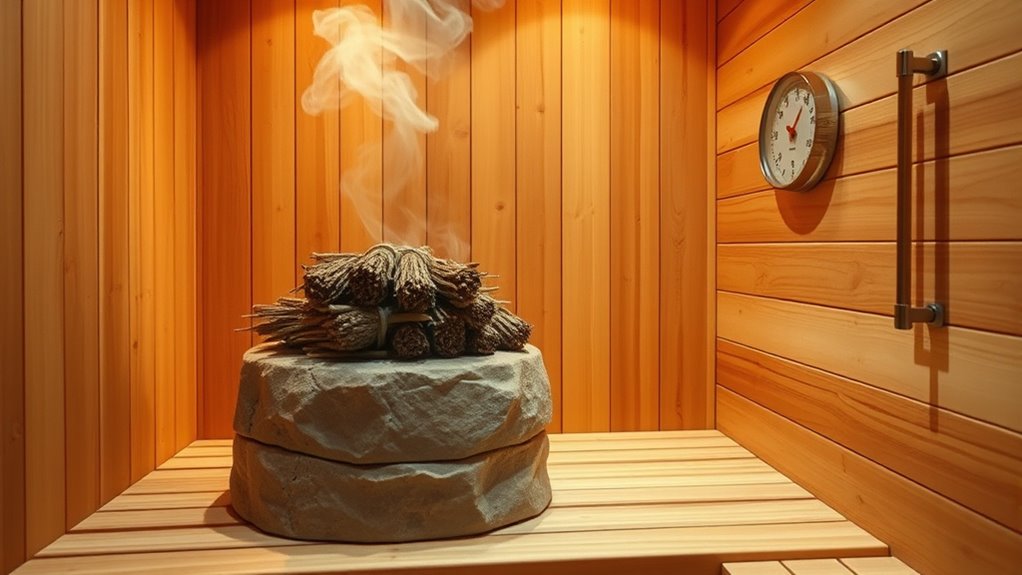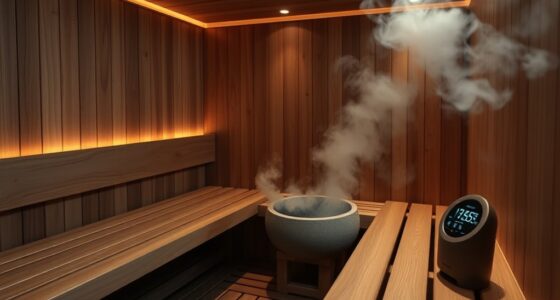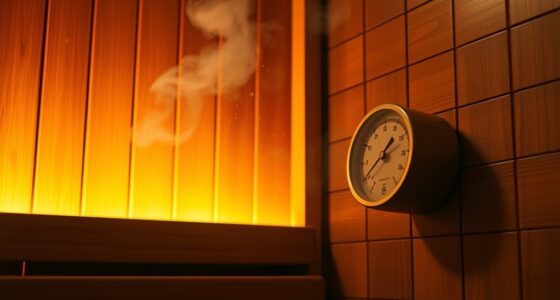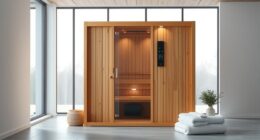If you want to enjoy a sauna safely, it’s crucial to understand basic health and safety tips. This includes knowing the right temperature range, staying hydrated, and recognizing signs of overheating like dizziness or nausea. Proper sauna etiquette and session duration are also important for a relaxing experience. By following these guidelines, you’ll maximize benefits while minimizing risks. Keep exploring to discover how to make your sauna sessions safer and more enjoyable.
Key Takeaways
- Understand different sauna types, components, and safety vocabulary to ensure proper use and maintenance.
- Follow proper etiquette, session durations, and cooling practices for safe and respectful sauna experiences.
- Monitor temperature and humidity levels to prevent overheating, dehydration, and health risks.
- Stay hydrated before, during, and after sessions; recognize signs of overheating and respond promptly.
- Adhere to safety guidelines, including gradual time increase and post-session cooling, to maximize benefits and prevent accidents.
What Is a Sauna?
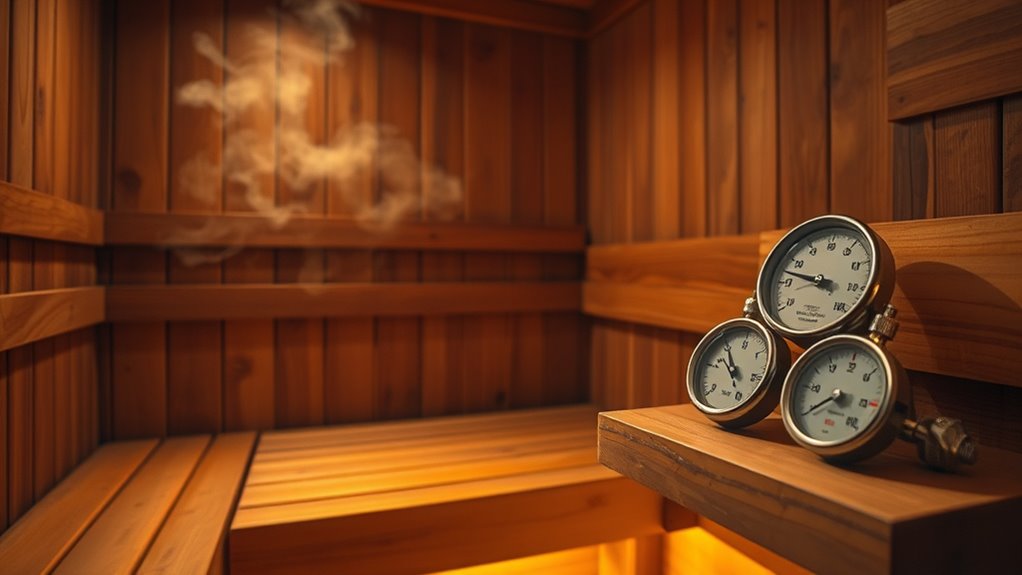
A sauna is a small room designed for heat sessions that promote relaxation and health benefits. Its history dates back thousands of years, originating in Finland, where sauna design became central to daily life and wellness practices. Traditional saunas feature wooden interiors, often made of cedar or pine, with benches arranged for comfortable seating. Modern designs may incorporate electric or wood-burning heaters, creating high temperatures that induce sweating. The purpose of a sauna is to provide a controlled environment for heat therapy, helping to relax muscles, improve circulation, and promote detoxification. Understanding sauna history and design helps you appreciate its cultural significance and the thoughtfulness behind creating a safe, effective space for heat sessions. Additionally, proper sauna safety measures are essential to prevent overheating and dehydration during use.
Proper Sauna Etiquette
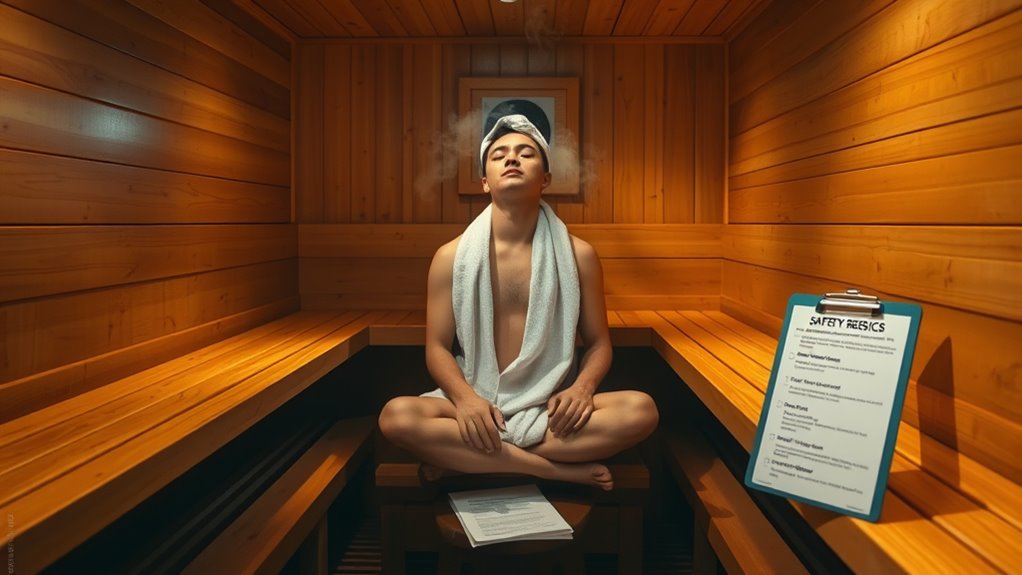
To guarantee everyone enjoys a comfortable and respectful experience, practicing proper sauna etiquette is essential. Respectful behavior includes keeping noise levels low and avoiding loud conversations, so others can relax peacefully. Always shower before entering the sauna to keep it clean and hygienic. Use a towel to sit on, and don’t bring food or drinks inside. Keep your time in the sauna reasonable to allow others a turn, and leave quietly when you’re finished. Avoid applying lotions or perfumes, as strong scents can disturb others. Remember, sauna etiquette promotes a calming environment where everyone feels comfortable. Being mindful of personal space and respecting others’ privacy helps create a positive atmosphere for all guests. Your respectful behavior enhances the shared experience and maintains the sauna’s relaxing vibe. Understanding city dynamics and local customs can also enrich your sauna experience, making it more enjoyable and culturally respectful.
Key Terms and Definitions

Understanding key sauna terms helps you stay safe and informed during your experience. You’ll learn essential safety vocabulary that clarifies proper practices and precautions. Let’s review these important definitions so you can enjoy the sauna responsibly.
Essential Sauna Terms
Have you ever wondered what all those sauna-specific terms really mean? Understanding these key terms helps you enjoy sauna sessions safely and confidently. For example, “heating element” refers to the device that warms the sauna, while “humidity level” measures moisture in the air, affecting your comfort. Knowing “infrared sauna” distinguishes it from traditional models, and “steam generator” is essential for creating humid heat. Many sauna myths persist, but knowing the facts about historical sauna practices clarifies their purpose and safety. Here are some essential sauna terms to get you started:
- Banya: Russian-style sauna with steam and wood heating
- Heater: Device that warms the sauna space
- Humidifier: Adds moisture to the air
- Infrared: Sauna type using infrared light for heat
Understanding these terms enhances your sauna experience and safety awareness. High-pressure systems are common in airless paint sprayers and contribute to their efficiency.
Safety Vocabulary Overview
Are you familiar with the essential safety terms you need to know before enjoying a sauna session? Understanding key terms helps you stay safe and get the most out of your experience. “Sauna equipment” refers to the tools and devices used during your session, like heaters, thermometers, and humidity controls. Proper “sauna maintenance” ensures this equipment functions safely and efficiently. Knowing what these terms mean helps you identify potential hazards, like faulty heaters or poorly maintained benches. Always check your sauna’s equipment and its condition before use. Regular sauna maintenance prevents accidents and prolongs equipment lifespan. By familiarizing yourself with this safety vocabulary, you empower yourself to enjoy your sauna safely and responsibly, making your relaxation time both enjoyable and secure. Additionally, understanding cookie categories can help you make informed choices about your online privacy when researching sauna safety tips.
Safe Temperature Ranges
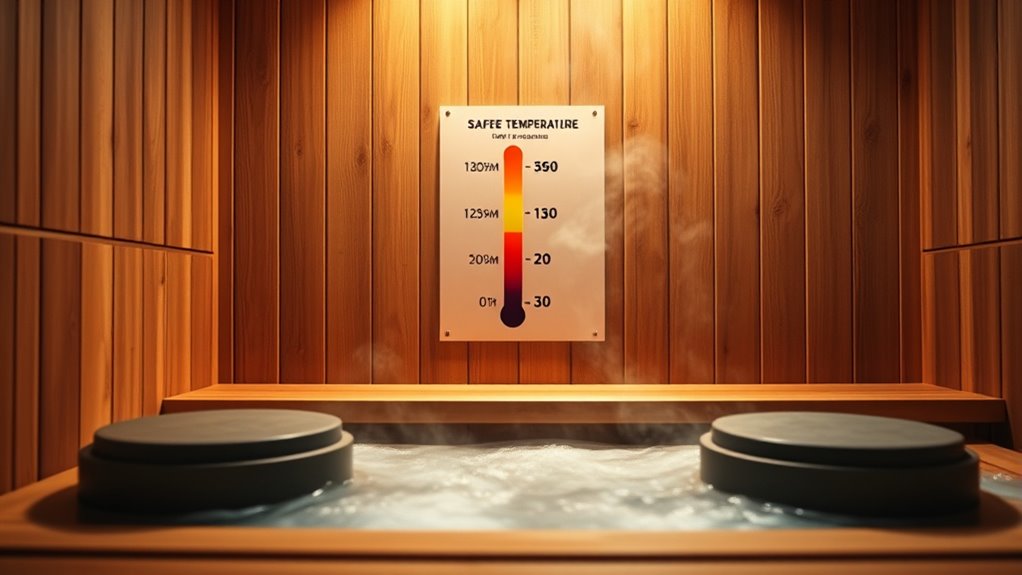
You should aim to stay within safe temperature limits to avoid overheating and health risks. Knowing your personal comfort zone helps prevent discomfort or dangerous situations. Understanding ideal temperature ranges ensures you enjoy the sauna safely and effectively. Monitoring ambient light levels can also enhance your safety by preventing excessive heat buildup caused by improper lighting conditions.
Optimal Temperature Limits
Maintaining the correct temperature in a sauna is essential for guaranteeing safety and maximizing health benefits. Optimal temperature limits generally range from 150°F to 195°F (65°C to 90°C), depending on your comfort and experience. To get the best experience, keep an eye on humidity levels, which influence how hot it feels, and ensure proper ventilation requirements are met. Proper airflow helps regulate temperature and prevents stuffiness. Here are key points to take into account:
- Keep temperatures within safe, recommended ranges
- Monitor humidity levels to avoid excessive moisture
- Guarantee ventilation is adequate for air circulation
- Adjust temperature based on your comfort and health needs
- Be aware of sauna safety guidelines to prevent overheating or dehydration.
Staying within these limits helps you enjoy the sauna safely while gaining health benefits.
Risks of Overheating
Exceeding the recommended temperature range in a sauna can considerably increase the risk of overheating, which may lead to dizziness, nausea, or even heat exhaustion. Staying within safe temperature limits helps prevent hydration risks and avoids putting unnecessary strain on your body. Overheating can cause your core temperature to rise rapidly, making you feel faint or unwell. To minimize risks, monitor the sauna temperature and listen to your body. Below is a quick guide:
| Temperature Range | Risks | Precautions |
|---|---|---|
| 150°F – 170°F | Increased dehydration | Hydrate regularly, limit sessions |
| 170°F – 190°F | Higher risk of heat exhaustion | Shorten exposure time |
| Above 190°F | Dangerous overheating | Avoid at all costs |
Proper sauna ventilation is essential for maintaining safe temperature levels and ensuring proper airflow.
Personal Comfort Zones
To enjoy the benefits of a sauna safely, it’s important to stay within your personal comfort zone, which typically corresponds to a specific temperature range. Your personal comfort guides your temperature regulation, helping you avoid overheating or discomfort. Recognizing your safe temperature range ensures a relaxing experience without risking health issues. Additionally, being aware of safe crypto opportunities can help you make informed choices outside of sauna safety. Here are key points to keep in mind:
- Listen to your body and adjust the heat accordingly
- Avoid temperatures that cause excessive sweating or dizziness
- Begin with lower temperatures and gradually increase
- Take breaks if you feel uncomfortable or overheated
Staying within your personal comfort zone helps you enjoy the sauna safely while maximizing health benefits. Remember, everyone’s ideal temperature range varies, so prioritize your own comfort and safety.
Hydration and Fluid Intake
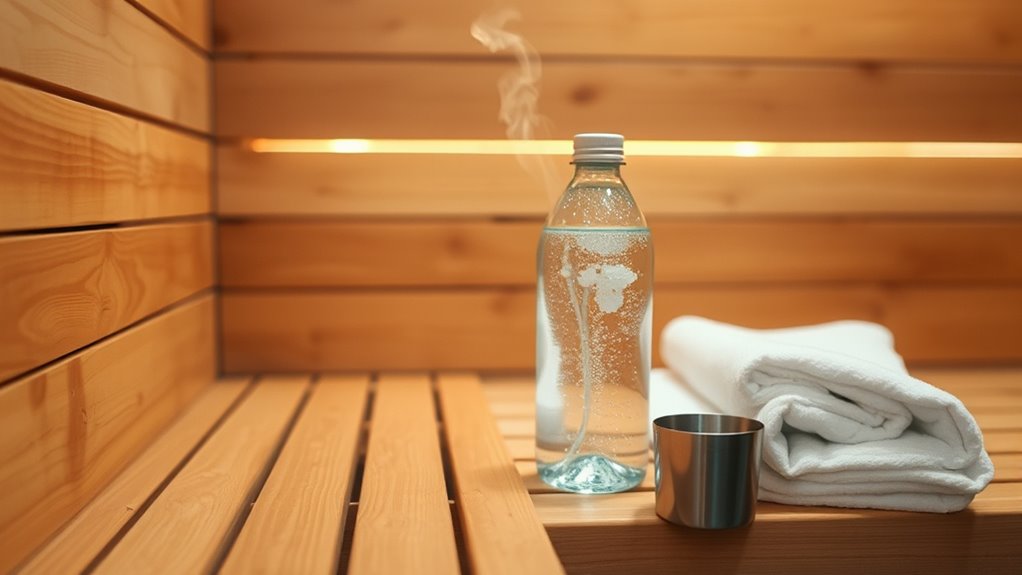
Staying properly hydrated is essential when using a sauna, as the high heat causes your body to sweat more and lose fluids rapidly. To maintain your fluid intake, drink plenty of water before, during, and after your session. This helps support your electrolyte balance, which is vital for muscle function and overall health. Avoid beverages with high sugar or caffeine content, as they can dehydrate you further. If you plan to sweat heavily or stay in the sauna for an extended period, consider electrolyte drinks to replenish lost minerals. Listening to your body’s signals is key—if you feel thirsty or dizzy, hydrate immediately. Proper hydration not only enhances your sauna experience but also reduces the risk of dehydration and associated health issues. Incorporating proper hydration techniques ensures a safer and more effective sauna session.
Recognizing Signs of Overheating
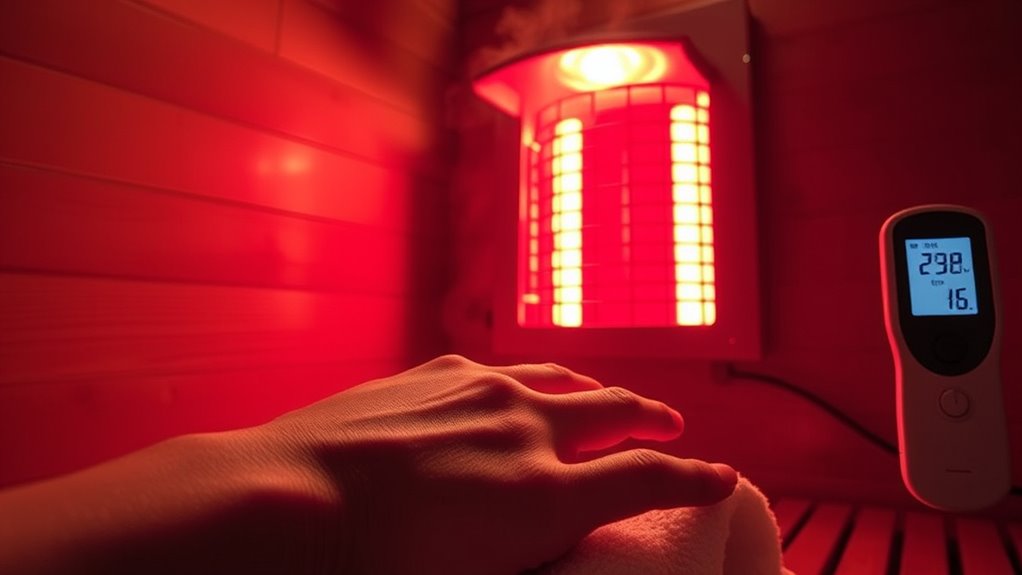
Recognizing the signs of overheating is essential to guarantee a safe sauna experience. If you notice symptoms of heat exhaustion or signs of dehydration, it’s a clear warning to cool down immediately. Look out for:
- Excessive sweating and weakness
- Dizziness or lightheadedness
- Nausea or vomiting
- Headaches or muscle cramps
These symptoms indicate your body is struggling to regulate temperature and fluids. Ignoring them can lead to more serious issues like heatstroke. If you experience any of these signs, exit the sauna, hydrate with water or electrolyte drinks, and rest in a cooler environment. Staying alert to these cues helps prevent overheating and ensures you enjoy your sauna safely. Always listen to your body and don’t push through discomfort. Monitoring your body temperature during sauna sessions can further help prevent overheating.
Duration of Sauna Sessions
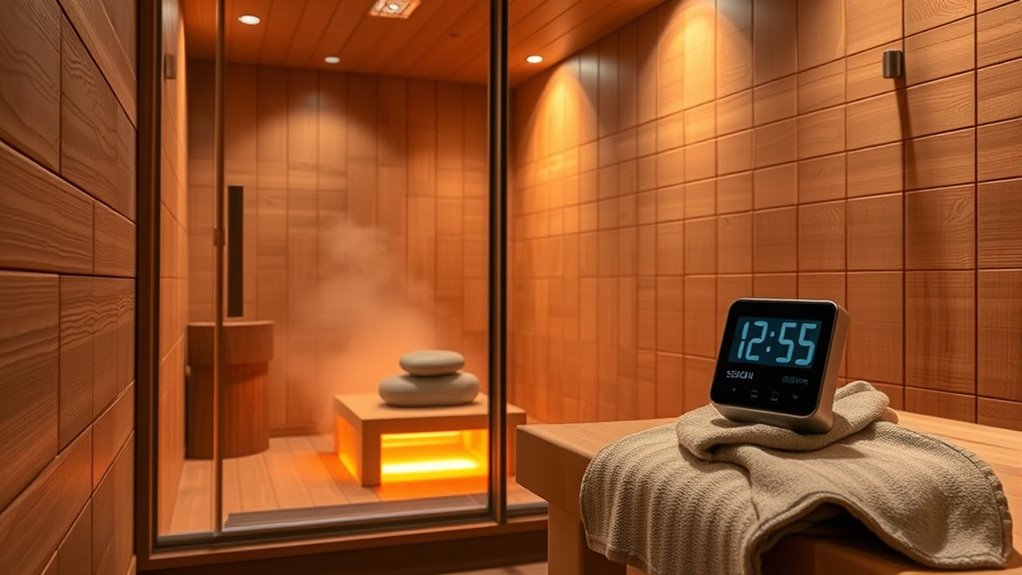
Limiting your time in the sauna is essential for maintaining safety and preventing overheating. Typically, a safe sauna session length varies depending on your experience and comfort level, but most guidelines recommend staying in for 15 to 20 minutes. Following session duration guidelines helps you enjoy the benefits without risking dehydration or heat exhaustion. Beginners should start with shorter sessions, around 10 minutes, and gradually increase as they become accustomed to the heat. Always listen to your body—if you feel dizzy, lightheaded, or uncomfortable, it’s time to exit. Remember, longer isn’t always better, and respecting recommended session durations ensures a safe, relaxing experience. Stay within these limits for healthful benefits and safety.
Post-Sauna Care and Cooling Down
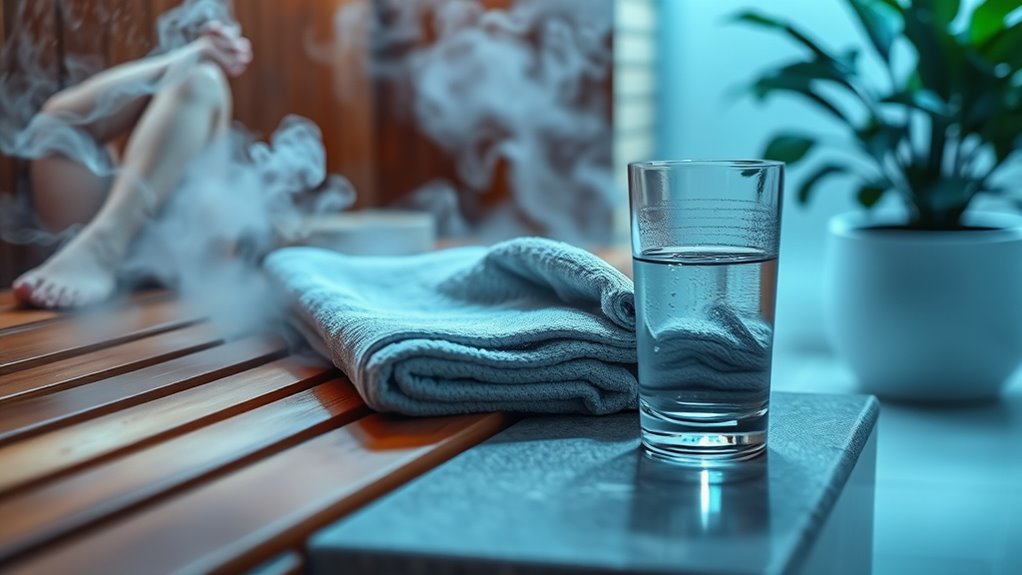
After your sauna session, taking time for proper cooling down helps your body recover and maintain safety. Cooling techniques are essential to prevent dizziness and promote circulation. Start by gradually lowering your body temperature with a lukewarm or cool shower, or simply step into a cool environment. Hydration is key—drink plenty of water to replenish fluids lost through sweating. You might also consider light stretching to relax muscles. Remember, don’t rush; give your body time to adjust. Proper post sauna care reduces the risk of dehydration and overheating. Keep these tips in mind:
- Use cooling techniques like cool showers or air
- Stay hydrated with water or electrolyte drinks
- Allow your body to cool gradually
- Avoid sudden temperature changes
Who Should Avoid Using Saunas

Certain health conditions make sauna use risky, so it’s important to know if you should avoid them. If you have heart problems, low blood pressure, or respiratory issues, saunas might worsen your condition. Pregnant women should consult their doctor before using a sauna, as heat can affect fetal health. People with certain skin conditions or infections should also avoid saunas to prevent irritation or spreading germs. Age restrictions apply; children and seniors with underlying health issues should seek medical advice before enjoying a sauna. If you’re taking medications that cause dizziness or dehydration, it’s best to skip sauna sessions. Always listen to your body and consult a healthcare professional if you’re unsure whether sauna use is safe for you.
Frequently Asked Questions
Can Pregnant Women Safely Use Saunas?
Pregnant women should avoid sauna exposure because it can pose risks to pregnancy safety. Elevated temperatures may increase the chance of dehydration, overheating, and fetal harm. It’s best to consult your healthcare provider before using a sauna, as they can offer personalized advice. To protect both you and your baby, prioritize safe practices and listen to your body’s signals during pregnancy.
Are There Specific Health Conditions That Prohibit Sauna Use?
If you have heart conditions or skin sensitivities, sauna use might not be safe for you. Studies show that over 80% of people with cardiovascular issues experience adverse effects from high heat. The intense heat can strain your heart or worsen skin sensitivities, leading to discomfort or health risks. Always consult your healthcare provider before enjoying a sauna if you have any health concerns, and listen to your body during your session.
How Frequently Should I Use a Sauna for Health Benefits?
You should aim for 2-3 sauna sessions per week, each lasting about 15-20 minutes. Keep your sauna session duration moderate to prevent overheating, and always listen to your body. Hydration tips are essential—drink plenty of water before, during, and after your session. Regular use can boost circulation and relaxation, but avoid overdoing it to stay safe and maximize health benefits.
What Are the Long-Term Risks of Regular Sauna Use?
Think of regular sauna use as walking a tightrope—you need balance to avoid falling. Long-term risks include chronic dehydration, which can dry you out like a desert, and cardiovascular strain, putting extra pressure on your heart. Overdoing it may lead to dizziness or fainting. To stay safe, limit sessions and stay hydrated, ensuring you enjoy the benefits without risking your health.
Do Different Sauna Types Require Different Safety Precautions?
Different sauna types do require specific safety precautions. For example, infrared saunas need proper ventilation standards to prevent overheating, while traditional saunas require good insulation to maintain high temperatures safely. Always check sauna insulation and ventilation standards to avoid risks like burns or heat exhaustion. Adjust your safety measures based on the type of sauna you’re using, ensuring proper airflow and temperature control for a safe and enjoyable experience.
Conclusion
By mastering these sauna health and safety basics, you’ll open a world of relaxation and wellness like no other. Remember, respecting proper etiquette, staying hydrated, and listening to your body guarantees your sauna experience remains safe and enjoyable. With this knowledge, you’re equipped to conquer the heat like a seasoned pro—transforming each session into a rejuvenating escape that’s truly unparalleled. Embrace these essentials, and let your sauna journey elevate your well-being to legendary heights.
